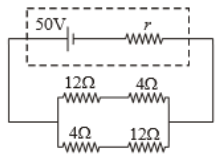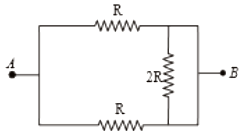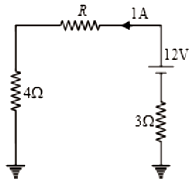The resistances of the four arms P, Q,R and S in a Wheatstone's bridge are 10Ω ,30Ω ,30Ω and 90Ω, respectively. The emf and internal resistance of the cell are 7 V and 5 Ω respectively. If the galvanometer resistance is 50Ω, the current drawn from the cell will be
(1) 1.0A
(2) 0.2A
(3) 0.1A
(4) 2.0A
| 1. | \(2~\Omega\) | 2 | \(1~\Omega\) |
| 3. | \(0.5~\Omega\) | 4. | zero |
In the circuit shown in figure find the value of r(internal resistance of the cell) for which power transferred by the cell is maximum

1.
2.
3.
4.
In the circuit shown in the figure below, the current supplied by the battery is:

1. \(2~\text A\)
2. \(1~\text A\)
3. \(0.5~\text A\)
4. \(0.4~\text A\)
If a resistance coil is made by joining in parallel two resistances each of 20. An emf of 2V is applied across this coil for 100 seconds. The heat produced in the coil is
(1) 20 J
(2) 10 J
(3) 40 J
(4) 80 J
The equivalent resistance across AB is :

1. 2R
2. R/2
3. 4R/3
4. 3R/2
The equivalent resistance between points \(A\) and \(B\) in the circuit shown in the figure is:

| 1. | \(6R\) | 2. | \(4R\) |
| 3. | \(2R\) | 4. | \(R\) |
In the circuit shown in the figure, the effective resistance between A and B is:

1. 2
2. 4
3. 6
4. 8
For the circuit shown in the figure, the value of R must be

1. 3
2. 4
3. 5
4. 6






